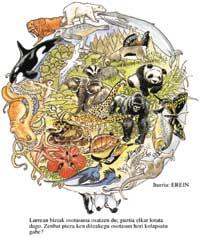Before the sixth major destruction: the Melontozoic Age
1995/04/01 Nuñez-Betelu, Koldo Iturria: Elhuyar aldizkaria
Species extinction is a frequent biological process. In short, like the two sides of the same coin, destructions and evolution are related. However, by destroying a species, being genetically unrepeatable becomes extinct FOREVER.
Species extinction occurred during the Eon Fanerozoico. Many of these extinctions were philetic, that is, they evolved into new species. But many other extinctions were the terminals, that is, the species disappeared without offspring. Thus, it is estimated that on our planet there were between 5,000 and 50,000 million species, and currently there may be 40 million species, representing 1% of the existing ones to date. This means that the degree of survival of the species is very low, since 99% of the species has expired.

Destruction terminals were produced continuously by biotic and abiotic factors. However, at various times in the Geological History there were simultaneously numerous terminals of destruction that became massive. In the well-known Five Great Extinctions of Fanerozoico, the massive terminals of destruction caused great losses to biodiversity. At the end of the Ordovician, Devonian, Perar, Triassic and Cretaceous Period numerous families and species were lost forever. The largest of these five extinctions occurred at the end of the Persian Period, that is, at the end of the Paleozoic Era, and 50% of marine families, including 80% of marine species, were destroyed in this double extinction. Closer to time, the massive destruction of the Cretaceous occurred at the end of the Mesozoic Era, which ended with the extinction of 15% of marine families and dinosaurs on land.
The destruction of species can be caused by climatic changes, meteor falls, immense volcanic eruptions, genetic deterioration, demographic dysfunctions and pests, among others. However, the cause of the major terminals of mass destruction has always been abiotic, since in these destructions there is no ecological gradient.
On the contrary, although the terminals of destruction are a continuous biological phenomenon, we are currently facing a great acceleration of this type of destruction. Thus, until the middle of this century, every year less than 10 species were destroyed on our planet. Since then the extinction rate has increased exponentially and now it is estimated that about 100 species per day are destroyed, most unknown to taxonomy. Since the fossilization process is very random and low yield, most species that are being destroyed right now will not even be known.
Therefore, and seeing the current accelerated expiration rate, it is very clear that we are immersed in massive terminal destruction. But this is not like the Five Great Extinctions, as the present cause is biotic. We humans are the cause of this destruction. This destruction, which already has its mark at the biostratigraphic level, will become the Sixth Great Destruction, initiating a new geological form.
Thus, human beings can be witnesses and actors of the end of the Zeonozoic Age if we do not yet maintain the current level of biodiversity. Moreover, if we do not slow down the current pace of destruction, we too could disappear. The geological form after this extinction, which we might call the Melontozoan Era (Greek, Melon = future), if any species persists, will form part of the Fanerozoan Eon. Otherwise, the Earth's geological calendar will be included in a new eon. But then there will be no paleontology to investigate what happened.

Gai honi buruzko eduki gehiago
Elhuyarrek garatutako teknologia





